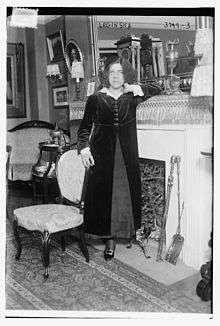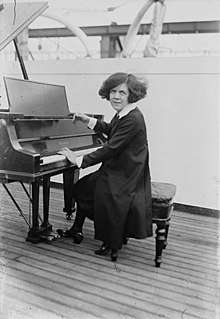Ethel Leginska

Ethel Liggins (13 April 1886 – 26 February 1970) was a British pianist, composer, conductor and music educator.
She was a student of Theodor Leschetizky, later studying composition with Rubin Goldmark and Ernest Bloch, and conducting with Eugene Goossens, Robert Heger and Gennaro Papi.[1] Among her students were pianist and harpsichorist Gavin Williamson, James Henry Fields, Daniel Pollack and Bruce Sutherland.[2] She was a pioneer of women's opportunity in music performance and conducting,[3] being the first woman to conduct many of the world's leading orchestras.[2]
Biography
Ethel Liggins was born in Hull, Yorkshire, England,[4] to Thomas and Annie Peck Liggins.[2] With support from wealthy patron Mary Emma Wilson, the wife of the shipping magnate Arthur Wilson, she attended the Hoch conservatory in Frankfurt, where she studied piano under James Kwast, and composition under Bernhard Sekles and Iwan Knorr.[2] She also studied in Vienna with the famed Polish pianist and professor, Theodor Leschetizky.[4] She went on tour in Australia in 1905,[5] and performed in Europe under the stage name Ethel Leginska from 1906 on, at the suggestion of British socialite Lady Maud Warrender (the wife of Sir George Warrender), as at that time the best top-class musicians were Polish, hence the Polish-sounding name "Leginska" considered advantageous to the development of the young pianist musical career.[6] She kept that name throughout her career and upon her debut in the United States she was dubbed by the press "The Paderewski of women pianists".[4][7][8]
In 1907 Leginska married the composer Emerson Whithorne, whom she had met when they both studied in Vienna. They would sometimes perform together, with him playing the second part in two-piano pieces on her recitals and from the time they married through 1909 him serving as her concert manager. He later wrote music criticism for "Musical America" and "Paul Mall Gazette", and as a composer, he had his music performed frequently in the 1920s and 1930s.[9] She and Emerson Whithorne had one son, Cedric Whithorne, born in September 1908[2] after the couple returned from visiting Whithorne's native United States. They did so at least once prior to their divorce, traveling to Cleveland, OH where Leginska make her unofficial American debut in Cleveland's Hippodrome, a vaudeville theater.[10] Nonetheless, the couple separated in 1910 and divorced in 1916.[1] After an unsuccessful custody fight for her son Cedric,[2] Leginska became even more outspoken about inadequate opportunities for women,[2] stating that self-sacrifice for family's sake is "over-rated" and that "it is impossible for a woman with a career to be unselfish".[11]
From her official American debut in New York's Aeolian Hall on 20 January 1913,[2] Leginska's popularity in the U.S. was growing, aided by both the careful staging of her performances, with well-thought-out lighting and decor to focus on the performer, and her distinctive style of dressing (favoring menswear) eagerly copied by her young fans, as well as her diminutive size and her youthful appearance that not only made the musical youth more likely to relate to her, but often misled not only her audiences but even the reviewers who would express their astonishment that a person so "young" displayed such skill as hers (this going on all the way into Leginska's late thirties, as made evident in the Detroit News critic Robert Kelly's description of her perform at 37).[12] In 1923, Leginska went to London to study orchestral conducting with Eugene Goossens.[2] She also studied conducting with Robert Heger, conductor of the Bavarian State Opera in Munich, proceeding to conduct as guest conductor with major orchestras in Munich, Paris, London or Berlin, taking advantage of her earlier contacts established when she performed as a pianist, as well as agreeing to also perform in a concerto on the programs.[6] Being a woman conductor also helped her attract attention, as a novelty. She conducted a performance of her orchestral suite Quatre sujets barbares.[2] In 1925, she made her debut as a conductor in the United States with the New York Symphony Orchestra in Carnegie Hall,[2] after which she appeared with the Boston People's Orchestra in the spring and then performing at the Hollywood Bowl in the summer of 1925. She had suffered nervous breakdowns in 1909, 1925 and 1926.[13][14] In 1926 she announced a permanent retirement from performing as a pianist and focused on conducting, composing and teaching.[6]

Though her output as a composer was limited, she distinguished herself as an organizer, establishing the Boston Philharmonic Orchestra which she conducted (1926–27), heading the Boston Woman's Symphony Orchestra (1926-1930) with which she went on two extensive tours.[15] She also directed the Boston English Opera Company,[16] founded the National Women's Symphony Orchestra in New York in 1932 and served as director of the Chicago Women's Symphony Orchestra.[16] In the late 1930s, when her conducting opportunities began to diminish as her novelty wore off, she left the U.S. again, to teach piano in London and Paris before settling in 1939 in Los Angeles. She opened a piano studio and was a well-respected teacher into the 1950s. In the meantime, in 1943, she founded the concert series New Ventures in Music, with Mary Holloway, mainly to promote her pupils.[2][17] In 1957 she once again conducted - a Los Angeles performance of her first opera The Rose and the Ring, written in 1932.
Ethel Leginska died in Los Angeles of a stroke on 26 February 1970, aged 83.[18][19]
As professor
After 1935, work opportunities seem to decrease for Leginska. In 1938, she lived in London and Paris where she taught, before finally settling in Los Angeles in 1939. There she worked as a piano teacher of notable reputation. Among Leginska's students were pianist and harpsichordist Gavin Williamson, (Williamson was also a long-time student of Artur Schnabel), James Henry Fields, Daniel Pollack, Bruce Sutherland.[20]
In a book by Harriette Brower, Piano Mastery: Talks with Master Pianists and Teachers published in 1915, the following is said about Leginska: "I believe in absolute freedom in all parts of the arm, shoulder to fingertips. Rigidity seems to me the most reprehensible thing when playing the piano, which is the most common of all kinds of performers default."[21]
In 1943, Leginska and her concert manager, Mary V. Holloway, founded the concert series New Ventures in Music with the purpose of introducing her talented young pupils to the public by having them perform works of great composers in recital.[22] The scope of the concerts were such that by the end of the second year of the series, the two books of Bach's Well-Tempered Clavier as well as all of Beethoven's sonatas and variations had been performed by the young musicians. The third and fourth series of concerts were devoted to the entire works of Chopin and Schumann.[23] The concerts were a great success, receiving accolades from world celebrities such as Bruno Walter, Arthur Rubinstein, and Serge Koussevitsky, and became a fixture of the musical life in Los Angeles. When piano concertos were performed, Leginska hired members of professional orchestras such as the Los Angeles Philharmonic and formed her own "Leginska Little Symphony," which she conducted herself.
As composer
In addition to her concert career, Leginska took courses in harmony with Rubin Goldmark from 1914,[2] and lessons in composition with Ernest Bloch in New York from the summer of 1918 on.[2] She soon followed these classes with composition of a range of pieces for piano and chamber ensembles.
The first work performed in public, which was something rare for a woman at the time, was a string quartet inspired by four texts by the Indian poet Tagore,[2] which won a composition prize in the Berkshire Chamber Music Festival Competition. The symphonic poem Beyond the Fields We Know with the title borrowed from poet Lord Dunsany came shortly after. The Gargoyles of Notre Dame was inspiered by Victor Hugo's novel The Hunchback of Notre Dame, and her four-movement orchestral suite Quatre sujets barbares is a musical work inspired by the life and paintings of French artist Paul Gauguin.[2]
In 1957 in Los Angeles, Leginska gave the premiere of her opera The Rose and the Ring, based on William Makepeace Thackeray's story of the same name, written a quarter of a century earlier.[2]
Works
Ethel Leginska's body of work is relatively small, consisting of piano pieces and songs, excluding her orchestral works and three operas. Among her major compositions are quartets for strings and piano, four Poems and six nursery rhymes. Many of her works are still unpublished.
Melodies
Orchestral
|
Chamber music
Piano
Opera
|
See also
References
- 1 2 "Women At The Piano - An Anthology Of Historic Performances, Vol. 3 (1928-1954)". Naxos.com. Retrieved 25 September 2016.
- 1 2 3 4 5 6 7 8 9 10 11 12 13 14 15 16 17 Love Griffin, Melodie. "Ethel Leginska: Pianist, Feminist, Conductor xtraordinaire, and Composer" (PDF). Sail.cnu.edu. CNU.
- ↑ Phenix, Katharine (1996). Subject guide to women of the world.
- 1 2 3 Marguerite Broadbent, Terry Broadbent. "Leginska: Forgotten Genius of Music The Story of a Great Musician". Leginska.org. Leginska.org.
- ↑ "Town Hall Sydney". The Freeman's Journal. Sydney, NSW. 9 September 1905.
- 1 2 3 Sicherman, Barbara, and Carol Hurd Green. 1980. Notable American women: the modern period : a biographical dictionary. Cambridge, Massachusetts: Belknap Press of Harvard University Press. p. 416
- ↑ "Princess Daisy of Pless: The Happy Years. An exhibition at Castle Pless". Rvondeh.dircon.co.uk. Retrieved 25 September 2016.
- ↑ "72002 for PDF 11/05" (PDF). Ivoryclassics.com. Retrieved 25 September 2016.
- ↑ Macleod, Beth Abelson. 2000. Women performing music: the emergence of American women as classical instrumentalists and conductors. Jefferson, NC: McFarland. p. 97
- ↑ Women Performing Music: The Emergence of American Women as Instrumentalists and Conductors. By Beth Abelson Macleod. Jefferson, North Carolina and London: McFarland & Company, 2001, p.97
- ↑ Women Performing Music: The Emergence of American Women as Instrumentalists and Conductors. By Beth Abelson Macleod (Jefferson, North Carolina and London: McFarland & Company, 2001, p. 98
- ↑ Macleod, Beth Abelson. 2000. Women performing music: the emergence of American women as classical instrumentalists and conductors. Jefferson, NC: McFarland. p. 102
- ↑ "Leginska Is Found, Her Mind A Blank. Reported In Boston. Pianist Who Vanished Last Monday Said To Be In A Sanitarium". New York Times. February 2, 1925.
- ↑ "Leginska Missing Again. Pianist Disappears While Audience Awaits Her In Evansville". New York Times. January 21, 1926.
- ↑ Sicherman, Barbara, and Carol Hurd Green. 1980. Notable American women: the modern period : a biographical dictionary. Cambridge, Massachusetts: Belknap Press of Harvard University Press. pp. 416-417
- 1 2 "Ethel Leginska". Forte-piano-pianissimo.com. 23 March 2016. Retrieved 25 September 2016.
- ↑ Sicherman, Barbara, and Carol Hurd Green. 1980. Notable American women: the modern period : a biographical dictionary. Cambridge, Massachusetts: Belknap Press of Harvard University Press. p. 417
- ↑ "Ethel Leginska". Pics-celeb.com. Retrieved 31 December 2010.
- ↑ Sadie, Julie Anne; Samuel, Rhian (1994). The Norton/Grove dictionary of women composers (Digitized online by GoogleBooks). ISBN 9780393034875. Retrieved 31 December 2010.
- ↑ "Ethel Leginska". Answers.com. Retrieved 12 July 2014.
- ↑ Harriette Brower. "Piano Mastery: Talks with Master Pianists and Teachers." NY: Frederick A. Stokes Company Publishers, 1915
- ↑ Marguerite and Terry Broadbent. "Leginska: Forgotten Genius in Music." Cheshire, UK: North West Player Piano Association, 2002, p. 242
- ↑ Marguerite and Terry Broadbent. "Leginska: Forgotten Genius in Music." Cheshire, UK: North West Player Piano Association, 2002, p. 243
External links

- Ethel Leginska plays Moszkowski's Valse Nr. 1, Op. 34 on the Duo-Art piano at YouTube